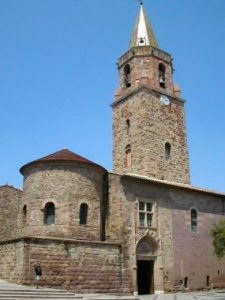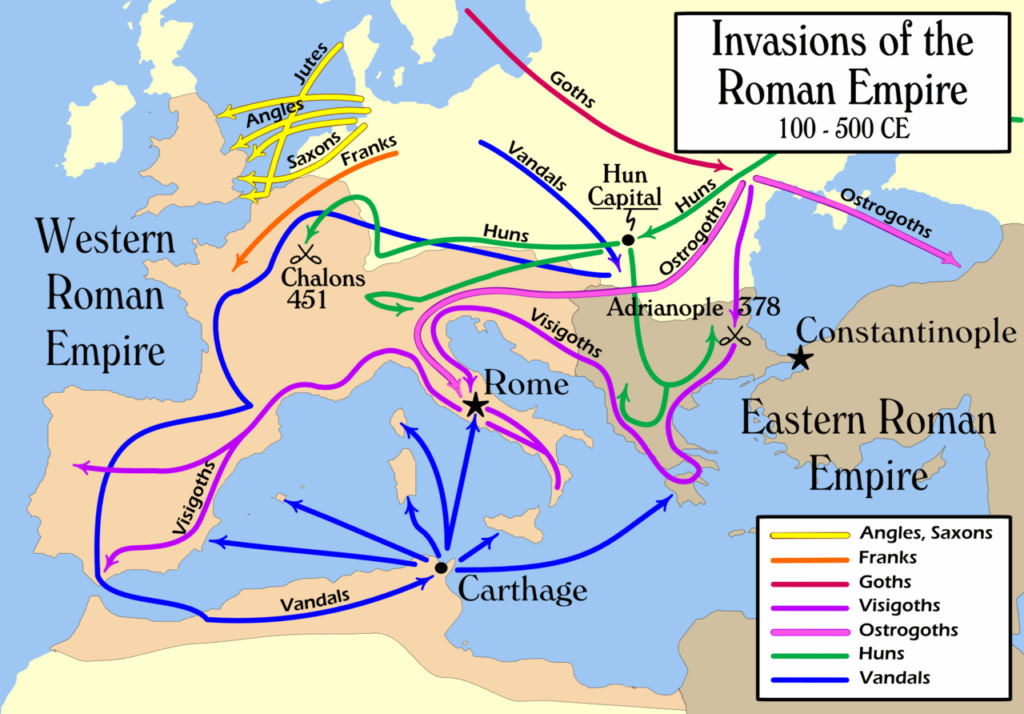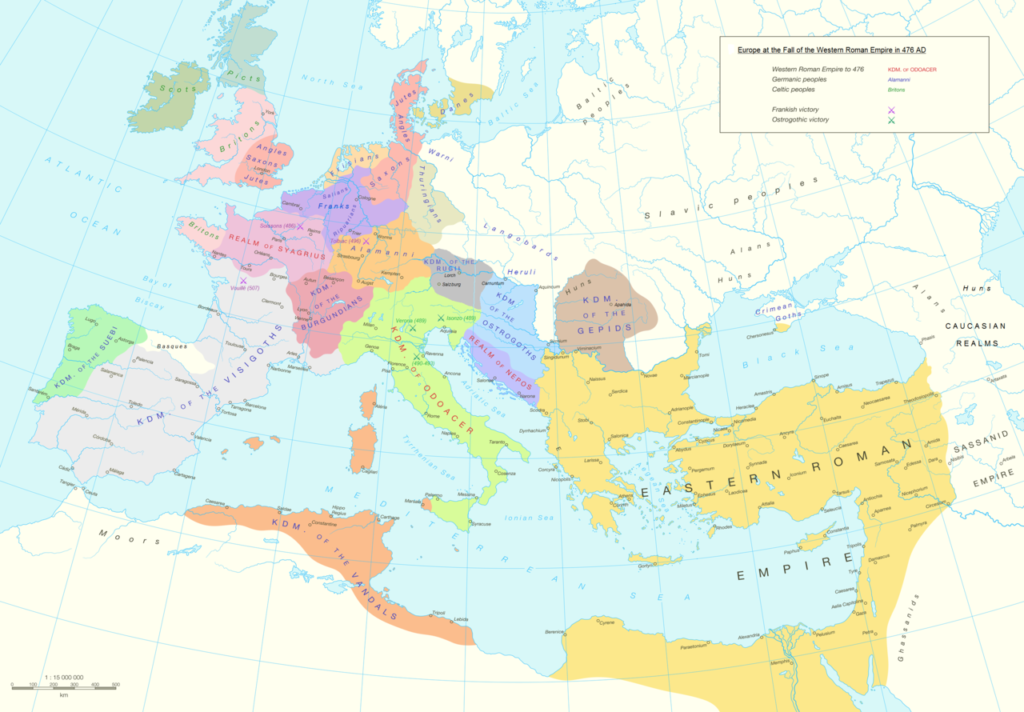The Barbarian invasions (3rd – 9th century), also called the Migration period or Dark Ages is the early medieval period of Western European history marked by frequent warfare and the virtual disappearance of urban life.

Image source:https://search.creativecommons.org/photos/de521568-ce1e-40ca-9439-9dba36e6705a by MumblerJamie
A Term in the Perspective of Romans and Greeks
The Barbarian invasions is a term used by the Romans and Greeks to refer to the Migration Period, which saw the spread of invasions of peoples within Europe, during the decline of the Western Roman Empire from 375 AD until the beginning of the 9th century. The term Barbarian invasions are now rarely used by historians as it is seen as a period of intellectual darkness and barbarism.

Image source: https://en.wikipedia.org/wiki/Barbarian#/media/File:De_Neuville_-_The_Huns_at_the_Battle_of_Chalons.jpg
“Barbarian” Art and Architecture
The invading tribes, once established in their new territories, began to develop personal art and architecture on the site. They share some fundamental traits but also vary according to the region of establishment and pre-existing art and culture. Two of the most spread styles were those of the Visigoths and the Franks.
Visigothic Art and Crafts
The Visigoths entered Hispania (modern-day Spain and Portugal) in 415 and became the dominant people there until the 711 invasions of the Moorish put an end to their reign.
This period in Iberian art is dominated by their style. Visigothic art is regarded in the English-speaking world as a strain of Migration art, while the Portuguese and Spanish-speaking worlds classify it as Pre-Romanesque.
The branches of Visigothic art include their architecture, their crafts (especially jewelry), and even their script.
The only remaining examples of their 6th Century architecture are the church of San Cugat del Vallés in Barcelona, the hermitage and church of Santa Maria de Lara in Burgos, The Chapel of Saint Frutuoso in Braga, and the church of São Gião in Nazaré.
Some of the features of their architecture are:
- Generally, basilica plan, sometimes with a Greek cross or a combination of the two.
- Horseshoe arches without keystones.
- An external rectangular apse.
- Use of columns and pillars with Corinthian capitals of unique design.
- Barrel vaults with domes on the crosses.
- Walls in ashlar blocks, occasionally alternating with Roman brick.
- Decoration of animal or plant motifs.

Image source: https://en.wikipedia.org/wiki/Visigothic_art_and_architecture
Merovingian Architecture: Traits and Style
Merovingian art and architecture date back to the Merovingian dynasty of the Franks, which lasted from the 5th century to the 8th century in present-day France and Germany.
The advent of the Merovingian dynasty in Gaul in the 5th century led to important changes in the field of arts. Sculpture regressed to become a simple technique for the ornamentation of sarcophagi, altars, and ecclesiastical furnishing. On the other hand, gold working and the new means of illuminating the manuscripts supplemented the “barbarian” decoration in animal style, with Late Antique motifs, and other contributions from Syria or Ireland to constitute Merovingian art.
The unification of the Frankish kingdom under Clovis I (465 – 511) and his successors, corresponded to the need to build churches, and especially monastery churches, considered the power plants of the Merovingian church. The plans often continued the tradition of the Roman basilica but were also influenced by Syria and Armenia. In the East, most structures were wooden, but the stone was more common for significant buildings in the West, and southern areas that later fell under Merovingian rule. Most of the main churches have been rebuilt, but many Merovingian plans have been rebuilt by archaeology.

Image source:https: //en.wikipedia.org/wiki/Merovingian_art_and_architecture
The “Barbarian Peoples”: Origin and Spread
Many of the migrations were movements of Germanic, Hunnic, Slavic, and other peoples into the territory of the then declining Roman Empire, with or without accompanying invasions or war. The “Barbarian peoples” included Huns, Goths, Vandals, Bulgars, Alani, Suebi, and Franks. Most of these tribes, like the Huns, the Visigoths, and the Ostrogoths came from eastern Europe and migrated towards the far west of the continent, some like the Vandals spread through the Mediterranean sea while others like the Saxons and Franks occupied the northern regions of Germany, France, and Britain.

Image source: https://en.wikipedia.org/wiki/Migration_Period
The Causes Behind the Migration
Various factors have contributed to this migrating phenomenon. Starting from 382, the Roman Empire and the individual tribes entered into treaties for their settlement in its territory. The Franks settled in the Roman Empire and were given the task of protecting the northeastern border of Gaul but they soon violated the Roman rule and crossed the Rhine. This event led to the beginning of a series of invasions by the Vandals and Suebi, giving power to both Germanic and Roman armies, which devastated Europe and the remnants of the Western Roman Empire.


Image source:https://search.creativecommons.org/photos/61c6ffe7-a95f-4853-9cd5-f7c09fe10a75
The Falling of the Western Roman Empire
There are contradicting opinions as to whether the fall of the Western Roman Empire was a result or a cause of these migrations. The Eastern Roman Empire was less affected by migrations and survived until the Fall of Constantinople at the hands of the Ottomans in 1453. In the Modern Period, the period of migration was seen as contributing to the fall of the empire. In the place of the fall of Western Rome, Barbarian kingdoms arose in the 5th and 6th centuries which decisively shaped the European Early Middle Ages.

Image source: https://en.wikipedia.org/wiki/Barbarian_kingdoms
Info sources:
https://www.penfield.edu/webpages/jgiotto/onlinetextbook.cfm?subpage=1492781
https://en.wikipedia.org/wiki/Migration_Period
https://www.britannica.com/event/Dark-Ages
